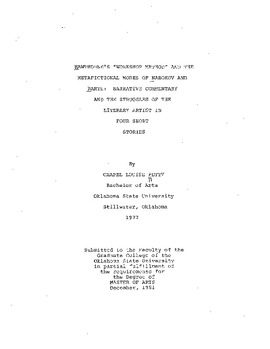| dc.contributor.advisor | Rohrberger, Mary | |
| dc.contributor.author | Petty, Chapel Louise | |
| dc.date.accessioned | 2015-08-27T16:44:33Z | |
| dc.date.available | 2015-08-27T16:44:33Z | |
| dc.date.issued | 1981-12-01 | |
| dc.identifier.uri | https://hdl.handle.net/11244/16821 | |
| dc.description.abstract | Based on the critical assumption that writers of short fiction, like other artists, progressively refine and develop the conventions of their genre, the following study compares two of Hawthorne's experiments in first-person narration with similar experiments of two twentieth-century fiction writers, Vladimir Nabokov and John Barth. The narrative commentary of Hawthorne's "Wakefield" and "The Seven Vagabonds" develops the theme of an artist's struggle to realize his own identity in his art; narrative commentary develops the same theme in Nabokov's "The Leonardo" and Barth's "Lost in the Funhouse." The similarities suggest that Hawthorne, early in his career and early in the development of the short story as a genre, experimented with narrative techniques and themes that remain of interest in the genre today. | |
| dc.format | application/pdf | |
| dc.language | en_US | |
| dc.publisher | Oklahoma State University | |
| dc.rights | Copyright is held by the author who has granted the Oklahoma State University Library the non-exclusive right to share this material in its institutional repository. Contact Digital Library Services at lib-dls@okstate.edu or 405-744-9161 for the permission policy on the use, reproduction or distribution of this material. | |
| dc.title | Hawthorne's "workshop Method" and the Metafictional Modes of Nabokov and Barth: Narrative Commentary and the Struggles of the Literary Artist in Four Short Stories | |
| dc.type | text | |
| dc.contributor.committeeMember | Luecke, Janemarie | |
| dc.contributor.committeeMember | Walkiewicz, Edward P. | |
| osu.filename | Thesis-1981-P512h.pdf | |
| osu.accesstype | Open Access | |
| dc.description.department | English | |
| dc.type.genre | Thesis | |
